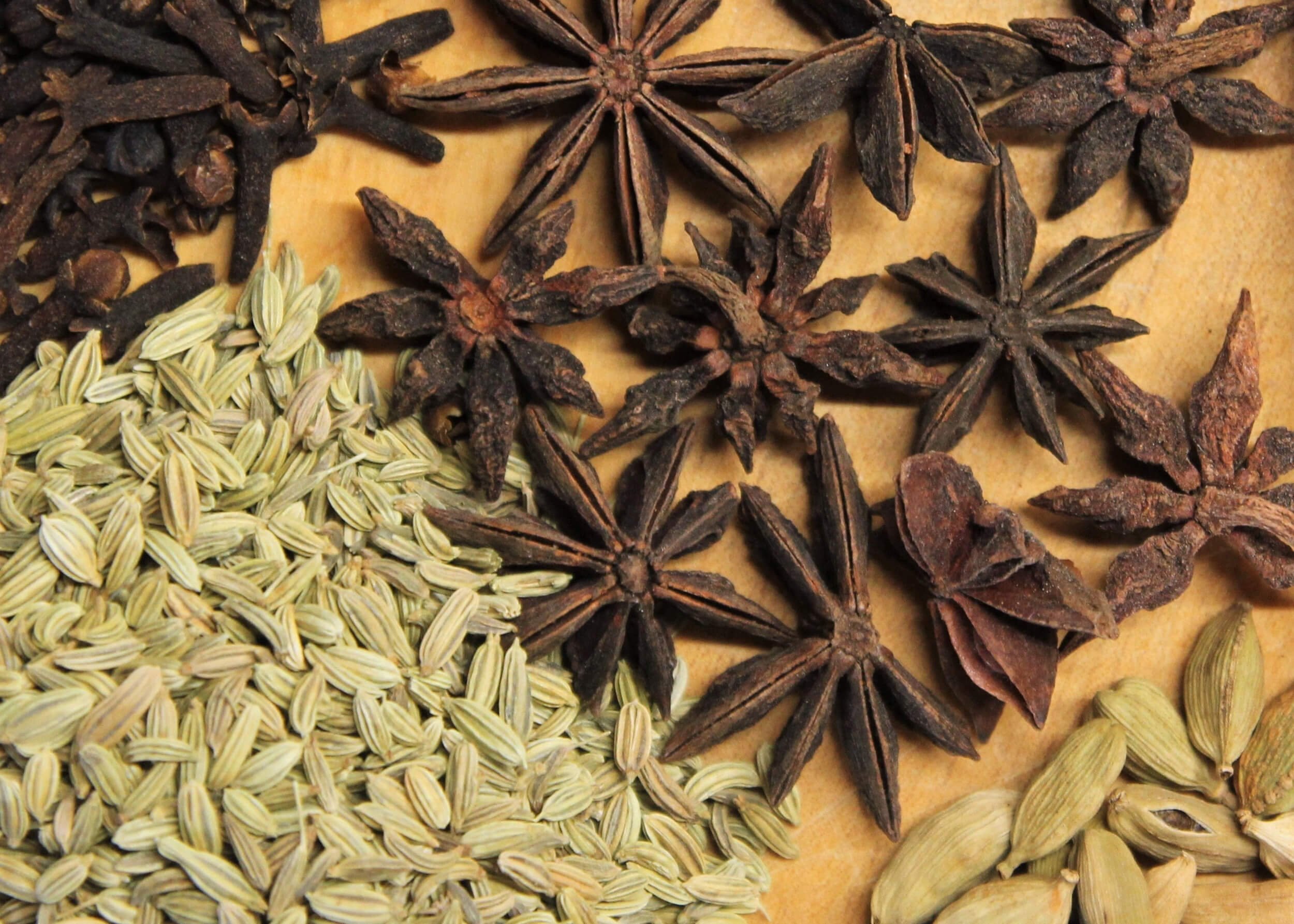Nine Chinese herbs commonly found in American kitchens
While they may belong to a different species or be prepared differently for therapeutic use, Chinese herbs can be found everywhere in the United States from dandelion patches to pumpkin pies. Here is a list of nine Chinese herbs that are likely well known to Americans, with a sprinkling of lesser-known facts to “spice” things up:
Cardamom
There are a few different Chinese herbs that classify as cardamom, all in the same family as ginger, which can be found farther down this list. Additionally, they can all be used to treat digestive symptoms of certain etiologies or causes. (In the picture above, cardamom, in the form of a pod, is on the lower right.)
Bái dòu kòu, round cardamom or cardamom cluster, literally means “white cardamom.”
Câo guô, tsaoko fruit, literally means “grass fruit.” It is part of an herbal remedy for malarial disorders.
Shā rén, amomum fruit or grains-of-paradise fruit, literally means “sand seeds.” It can be used both to support an unstable pregnancy (a pregnancy in which there is a high risk of miscarriage), and to assist the digestive system when cloying herbs might hamper it.
Cinnamon
The two Chinese herbs that classify as cinnamon actually have vastly different functions.
Guì zhī, cinnamon twig or cassia twig, literally means “cinnamon twig.” It is in a category of herbs that treat the common cold when it truly involves cold. In the system of medicine upon which the prescription of Chinese herbs is based, the common “cold” might involve heat instead. This herb is also in a formula that is often used to treat polycystic ovarian syndrome (PCOS).
Ròu guì, cinnamon bark or inner bark of Saigon cinnamon, can be used to treat pain and digestive symptoms of certain etiologies and also has particular gynecological and genitourinary applications.
Clove
Dīng xiāng, clove, literally means “spike fragrance,” referring to the shape of its flower bud. It can be used to treat digestive symptoms of certain etiologies and also has particular gynecological and genitourinary applications. (In the picture above, clove is on the upper left.)
Fennel
Xiâo huí xiāng, fennel fruit, literally means “small return fragrance,” referencing its ability to give a pleasant fragrance to food that has an unpleasant odor. It can also be used to treat shàn disorder (bulging/hernia disorder) as well as digestive symptoms of certain etiologies. (Dà huí xiāng, star anise, literally means “large return fragrance,” complementing the literal meaning of fennel’s Chinese name. In the picture above, star anise is on the upper right while fennel, in the form of a seed, is on the lower left.)
Garlic
Dà suàn, garlic bulb, used to be called hú, the Chinese character for which depicts grass on top of the word for “barbarian.” It can be used to kill parasites such as hookworms and pinworms. Additionally, It can be used to treat itchy rashes such as those caused by tinea; for this purpose it is typically applied topically (on the skin).
Ginger
The three Chinese herbs that classify as ginger are distinguished by how they are prepared.
Gān jiāng, dried ginger rhizome, literally means “dry ginger.” It can be used to treat digestive symptoms and respiratory symptoms of certain etiologies as well as a sensation of cold in the lower body.
Páo jiáng, quick-fried ginger, can be used to stop bleeding in the treatment of symptoms such as nosebleed and blood in the urine.
Shēng jiāng, fresh ginger rhizome, literally means “fresh ginger.” It is hailed for its ability to alleviate nausea but also serves a similar function as cinnamon twig in the treatment of the common cold. Additionally, it can be used to treat the effects of overdose of toxic herbs, and when combined with another Chinese herb it can be used to treat vomiting and diarrhea due to seafood poisoning.
Scallion
Cōng bái, scallion or spring onion, literally means “white allium” (it is in the Allium genus). It can be used to treat the common cold, especially in its very early stages.
Turmeric
The three Chinese herbs that classify as turmerlc are all in the ginger family.
É zhú, curcuma rhizome, can be used to treat menstrual disorders and digestive symptoms of certain etiologies. In addition, it has recently become an important herb in the treatment of solid cancers, particularly of the cervix.
Jiāng huáng, turmeric rhizome, literally means “ginger yellow.” It can be used to treat pain and menstrual disorders of certain etiologies, and is especially useful for shoulder pain that worsens in damp weather.
Yù jīn, curcuma tuber, literally means “constrained gold.” Golden-yellow in color, it helps to clear pain that is stuck or constrained. Additionally, it can be used to treat symptoms such as nosebleed and blood in the urine, as well as gallstones and jaundice.
Walnut
Hé táo rén, walnut, is also called hú táo rén, which literally means “barbarian peach kernels.” The walnut fruit originally came from the Qiang barbarians who lived in what is now the Sichuan area. Walnut can be used to treat constipation in the elderly or in the aftermath of a febrile disorder.
Note: The falling-rising or third tone in Chinese, a tonal language in which the meaning of an utterance can change depending on the intonation used, is typically indicated by a caron ( ̌) in the alphabet that English uses, but is represented here by a circumflex (ˆ) due to the limited diacritical marks available in this font.
References Consulted
Bensky D, Clavey S, Stöger E, Gamble A. Chinese Herbal Medicine: Materia Medica. 3rd ed. Seattle, WA: Eastland Press; 2004.
Chen JK, Chen TT. Chinese Medical Herbology and Pharmacology. Industry, CA: Art of Medicine Press; 2004.

